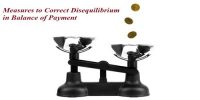Balance of Payments: According to Kindle Berger – “Balance of Payment is a systematic record of’ all economic transactions which take place among the individuals of a country and rest of the world”.
So, Balance of Payment is a systematic record of all economic transactions which take place among the individuals of a country and the rest of the world. It includes the balance of trade, the balance of services, balance of unilateral transfers, and balance of payment on capital account.
As per Harry Johnson – “Balance of Payment is a difference between total receipts and total payments of a country during one year”.
It means, B = Rr – Pr.
Where B = Balance of Payment,
Rr = Receipts from and
Pr = Payment to foreigners.
B.J. Cohen says – “The balance of payment is merely a way of listening receipts and payments in international transactions for a country”.
In short Balance of payments of a country is the annual record of economic relations of the country with the rest of the world. It gives the details of foreign exchange received or foreign exchange spends on various accounts.
Following items are included in the balance of payment –
Current Account: Current account is composed of imports and exports of visible goods. The current account of a nation incorporates all transactions associating to business in merchandise and services and unrequited transfers. If payments are greater than receipts, there is a deficit which is undesirable. In addition, the current account includes revenue from stocks.
The common major components of the current account are as follows:
- Visible trade – This is the net of export and imports of goods (visible items). The balance of this visible trade is known as the trade balance.
- Invisible trade – This is the net of exports and imports of services. Transactions mainly constitute of shipping, IT, banking and insurance services.
- Unilateral Transfers Account: Unilateral transfers is another term for gifts. These unilateral transfers include private remittances, government grants, disaster relief, etc. Unilateral payments received from abroad are credits and those made abroad are debits.
- Income receipts and payments – These are generally rent on the property, interest on capital and profits on investments.
Capital Account: The Capital Account consists of short- terms and long-term capital transactions. The capital account is used to finance the deficit in the current account or absorb the surplus in the current account. A capital outflow represents a debit and a capital inflow represents a credit. It is related to claims and liabilities of financial nature. The capital account also includes money received from debt-forgiveness and gift taxes.
The three major components of the capital account:
- Loans to and borrowings from abroad – These consist of all loans and borrowings given to or received from abroad.
- Investments to/from abroad – These are investments made by nonresidents in shares in the home country or investment in real estate in any other country.
- Changes in foreign exchange reserves – Foreign exchange reserves held by the central bank of a country to monitor and manage the exchange rate does impact the capital account.
Other components are –
Financial Account: The flow of funds from and to foreign countries through various investments in real estates, business ventures, foreign direct investments, etc. is monitored through the financial account. It also includes government-owned assets such as gold and Special Drawing Rights (SDRs) held with the International Monetary Fund (IMF).
Official Settlements Accounts: Official reserves represent the holdings by the government or administrator agencies of the means of payment that are usually accepted for the completion of international claims
Services: Transport, insurance, and services of labor, etc. are included in services.
Donation: Pensions and grants are included in the donation.














